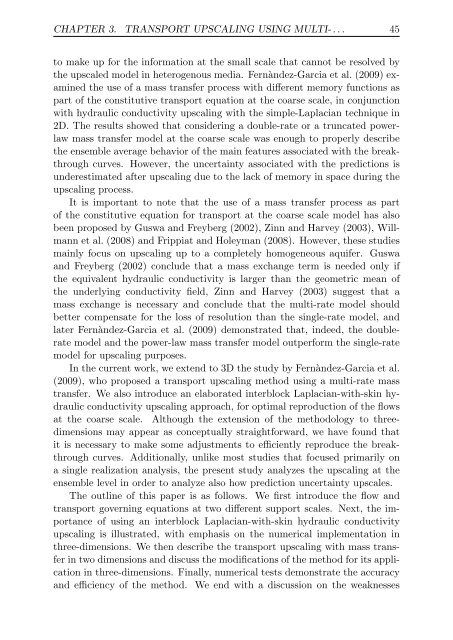Upscaling and Inverse Modeling of Groundwater Flow and Mass ...
Upscaling and Inverse Modeling of Groundwater Flow and Mass ...
Upscaling and Inverse Modeling of Groundwater Flow and Mass ...
Create successful ePaper yourself
Turn your PDF publications into a flip-book with our unique Google optimized e-Paper software.
CHAPTER 3. TRANSPORT UPSCALING USING MULTI- . . . 45<br />
to make up for the information at the small scale that cannot be resolved by<br />
the upscaled model in heterogenous media. Fernàndez-Garcia et al. (2009) examined<br />
the use <strong>of</strong> a mass transfer process with different memory functions as<br />
part <strong>of</strong> the constitutive transport equation at the coarse scale, in conjunction<br />
with hydraulic conductivity upscaling with the simple-Laplacian technique in<br />
2D. The results showed that considering a double-rate or a truncated powerlaw<br />
mass transfer model at the coarse scale was enough to properly describe<br />
the ensemble average behavior <strong>of</strong> the main features associated with the breakthrough<br />
curves. However, the uncertainty associated with the predictions is<br />
underestimated after upscaling due to the lack <strong>of</strong> memory in space during the<br />
upscaling process.<br />
It is important to note that the use <strong>of</strong> a mass transfer process as part<br />
<strong>of</strong> the constitutive equation for transport at the coarse scale model has also<br />
been proposed by Guswa <strong>and</strong> Freyberg (2002), Zinn <strong>and</strong> Harvey (2003), Willmann<br />
et al. (2008) <strong>and</strong> Frippiat <strong>and</strong> Holeyman (2008). However, these studies<br />
mainly focus on upscaling up to a completely homogeneous aquifer. Guswa<br />
<strong>and</strong> Freyberg (2002) conclude that a mass exchange term is needed only if<br />
the equivalent hydraulic conductivity is larger than the geometric mean <strong>of</strong><br />
the underlying conductivity field, Zinn <strong>and</strong> Harvey (2003) suggest that a<br />
mass exchange is necessary <strong>and</strong> conclude that the multi-rate model should<br />
better compensate for the loss <strong>of</strong> resolution than the single-rate model, <strong>and</strong><br />
later Fernàndez-Garcia et al. (2009) demonstrated that, indeed, the doublerate<br />
model <strong>and</strong> the power-law mass transfer model outperform the single-rate<br />
model for upscaling purposes.<br />
In the current work, we extend to 3D the study by Fernàndez-Garcia et al.<br />
(2009), who proposed a transport upscaling method using a multi-rate mass<br />
transfer. We also introduce an elaborated interblock Laplacian-with-skin hydraulic<br />
conductivity upscaling approach, for optimal reproduction <strong>of</strong> the flows<br />
at the coarse scale. Although the extension <strong>of</strong> the methodology to threedimensions<br />
may appear as conceptually straightforward, we have found that<br />
it is necessary to make some adjustments to efficiently reproduce the breakthrough<br />
curves. Additionally, unlike most studies that focused primarily on<br />
a single realization analysis, the present study analyzes the upscaling at the<br />
ensemble level in order to analyze also how prediction uncertainty upscales.<br />
The outline <strong>of</strong> this paper is as follows. We first introduce the flow <strong>and</strong><br />
transport governing equations at two different support scales. Next, the importance<br />
<strong>of</strong> using an interblock Laplacian-with-skin hydraulic conductivity<br />
upscaling is illustrated, with emphasis on the numerical implementation in<br />
three-dimensions. We then describe the transport upscaling with mass transfer<br />
in two dimensions <strong>and</strong> discuss the modifications <strong>of</strong> the method for its application<br />
in three-dimensions. Finally, numerical tests demonstrate the accuracy<br />
<strong>and</strong> efficiency <strong>of</strong> the method. We end with a discussion on the weaknesses


